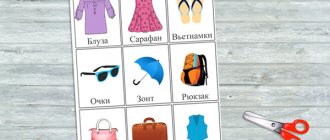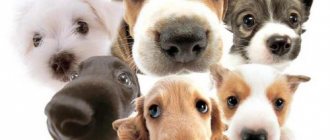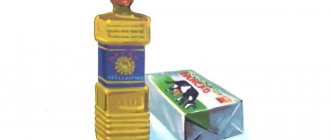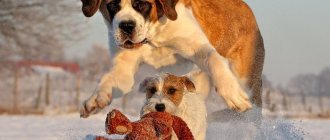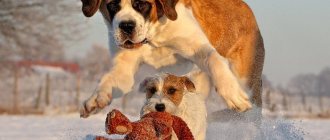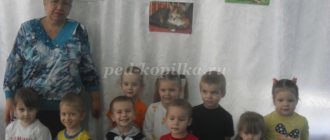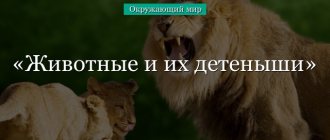Types of pictures
All cards for speech therapy classes can be divided into several groups.
Subject
Small cards, with one picture (an animal) on each. For example, in the series “Wild Animals of Our Forests” they will feature a wolf, an elk, and a badger.
“Animals of the North” set will consist of painted walruses, arctic foxes, and seals.
Plot
Illustration paintings with several characters and a plot. They help children write detailed, detailed stories using nouns, adjectives, and verbs. One plot picture allows you to discuss several topics at once: what benefits do pets bring, who cares for them, where they live.
brain teaser
A set of drawings depicting some kind of story, a plot in development. For example, some animals look different in winter and summer. An image of a squirrel in a gray and red coat, for example, allows a child to compose a story about the change of seasons and the preparation of animals for winter.
Drawings of wild animals and their cubs allow you to come up with a story about the childhood of a small animal.
Coloring pages
Outline images are another opportunity for the speech development of babies. High-quality coloring books help you master many new concepts and learn to use descriptive adjectives and prepositions. They also additionally stimulate the speech center (through regular fine motor skills training). Simple coloring pages can be used for children from 3 years old.
Coloring pages “Wild animals”
Didactic games on the topic “Wild Animals” card index on the world around us on the topic
Didactic games on the topic “Wild Animals”
Game “Name it in order” Goal: to develop visual memory and attention, to activate the vocabulary of nouns on the topic.
Look at the pictures and remember them. I will remove them all, you remember in order.
(6-7 subject pictures on the topic).
Game "Who has who?"
Purpose: using the genitive case of singular and plural nouns.
The bear has ... (bear cub, cubs). The fox has ... (fox cub, fox cubs). The squirrel has ... (baby squirrel, baby squirrels). The she-wolf has ... (wolf cub, wolf cubs). The hedgehog has ... (hedgehog, hedgehog). The hare has ... (little hare, little hares).
Game "Name the Family"
Goal: to introduce children to the names of wild animals and their families; develop children's speech.
Dad is a bear, mom is ... (mother bear), cub is ... (bear cub). Dad is a wolf, mom is ... (she-wolf), cub is ... (wolf cub). Dad is a hedgehog, mom is ... (hedgehog), baby is ... (hedgehog). Dad is a hare, mom is ... (hare), baby is ... (bare). Dad is a fox, mom is ... (fox), cub is ... (fox).
Game “Who Lives Where?”
Purpose: to consolidate the form of the prepositional case of nouns.
On the board are pictures of wild animals (bear, fox, wolf, squirrel, hare, etc.). On the teacher’s table are pictures of their homes (burrow, den, lair, hollow, bush). Children place a picture of a home under a picture of the corresponding animal.
The squirrel lives in a hollow. The bear lives in a den. The fox lives in a hole. The wolf lives in a den. The hare lives under a bush.
Game "Who loves what?"
Goal: to consolidate the accusative case of nouns.
On the teacher’s table there are pictures: carrots, cabbage, raspberries, honey, fish, nuts, pine cones, mushrooms, acorns, tree bark, grass, chickens, hares, sheep, etc. Children put pictures to the corresponding animal.
The squirrel loves nuts, cones, mushrooms, and acorns.
Game "Choose a Word"
Goal: to teach children to select and name feature words and action words.
Bear (what?) ... (brown, club-footed, clumsy). Wolf (what?) ... (gray, toothy, angry). Hare (what?) ... (long-eared, cowardly, timid). Fox (what?) ... (cunning, red, fluffy).
The bear (what is he doing?) ... (sleeping, waddles, clumsily). Wolf (what is he doing?) ... (howls, runs away, catches up). The fox (what is it doing?) ... (tracks, runs, catches).
Game “Recognize the beast by description”
Goal: to teach children to recognize animals by description; develop children's thinking and speech.
- Cowardly, long-eared, gray or white. (Hare.) - Brown, club-footed, clumsy. (Bear.) - Gray, angry, hungry. (Wolf.) - Cunning, red-haired, dexterous. (Fox.) - Agile, thrifty, red or gray. (Squirrel.)
The game “Who gives what voice?”
Goal: to introduce children to the voices of wild animals.
- Tell me, how do animals sound? - What does the wolf do - ... (howls). - What is the fox doing - ... (yelps). - What is the bear doing - ... (roars). - What does a squirrel do? ... (clicks).
Game “Name it kindly”
Goal: to teach children to form nouns using diminutive suffixes. Don't yawn, my friend, but say a word. Squirrel - squirrel Fox - fox
Game "One - Many"
Goal: to teach children to form plural nouns in the nominative and genitive cases. We are little wizards, There was one, but there will be many. Squirrel - squirrels - a lot of squirrels Bear - bears - a lot of bears
Game "Count!"
Goal: to teach children to coordinate nouns with the numerals “one”, “two”, “five”. We always know how many there are, We count everything well. One bear - two bears - five bears One hedgehog - two hedgehogs - five hedgehogs One squirrel - two squirrels - five squirrels
Didactic game “Whose tail? »Goal: consolidate knowledge about animals, develop memory, thinking, attention and fine motor skills.
Progress of the game: One morning the forest animals woke up and saw that everyone’s tails were mixed up: the hare had a wolf’s tail, the wolf had a fox’s tail, the fox had a bear’s tail…. The animals were upset. Is a wolf's tail suitable for a hare? Help the animals find their tails by answering the question “Whose tail is this?” "Here is the wolf's tail. What is he like? (gray, long). Whose tail is this? - wolfish. Whose tail is this - small, fluffy, white? - hare. Etc. Now all the animals have found their tails.
Game “Change the words according to the model”
Purpose: formation of possessive adjectives.
Fox nose - ... (fox nose). Fox paw - ... (fox paw). Fox eyes - ... (fox eyes). Fox hole - ... (fox hole).
Game "On the contrary"
Goal: formation of antonym words.
The elk is big, and the hare is ... (small). The wolf is strong, and the squirrel is... (weak). The fox has a long tail, and the bear has ... (short).
Game "Fourth wheel"
Goal: to teach children to identify their essential features in objects and make the necessary generalizations on this basis, to activate their subject vocabulary.
Look at the picture, name the extra object and explain your choice.
Squirrel, dog, fox, bear
Game "Fold the picture"
Goal: to teach children to put together a picture from parts; develop holistic perception, attention, thinking.
The child has a picture of a wild animal, cut into 4 parts. - What kind of animal did you get? (Fox.)
Game “Composing a story-description”
Goal: to teach children to compose a descriptive story about an animal based on a plan diagram, to develop children’s speech.
Children compose a story about the appearance of a wild animal according to plan.
Black and white pictures
Educational pictures about animals for kindergarten children with inscriptions allow you to study the inhabitants of the tundra - the north of Russia. Black-and-white or color cards with tundra animals introduce children to representatives of the fauna that they may never see in person. Children's pictures with the inhabitants of the tundra can help parents and educators in studying the topic “Wild Animals”. The north of our country - the tundra - is characterized by harsh nature, and children in kindergarten or school must know about how they eat and what kind of lifestyle the inhabitants of these regions lead.
Forest animals are also presented on our website. Forest inhabitants are not limited to the geography of the north of the country. Forest animals live in the middle zone, and even in the south.
We present pictures and photos of African animals. Educational pictures with the inhabitants of Africa will also allow you to get acquainted with representatives of the fauna, which your child will rarely or will not see in person. Africa is characterized by a hot, arid climate. The task of the teacher or parent is to tell what they eat and how lions, rhinoceroses, tigers, camels and other animals of distant Africa live.
Believe me, if you show your child black-and-white or color pictures of Russian animals as a visual aid, he will understand and remember any information presented to him much faster. Listen to this recommendation, and the result will not take long to arrive. You will soon see this for yourself.
So, you can find children's pictures with pets, inhabitants of the tundra, forest and Africa on our website. Introduce children to the natural environment and teach them to take care of it!
